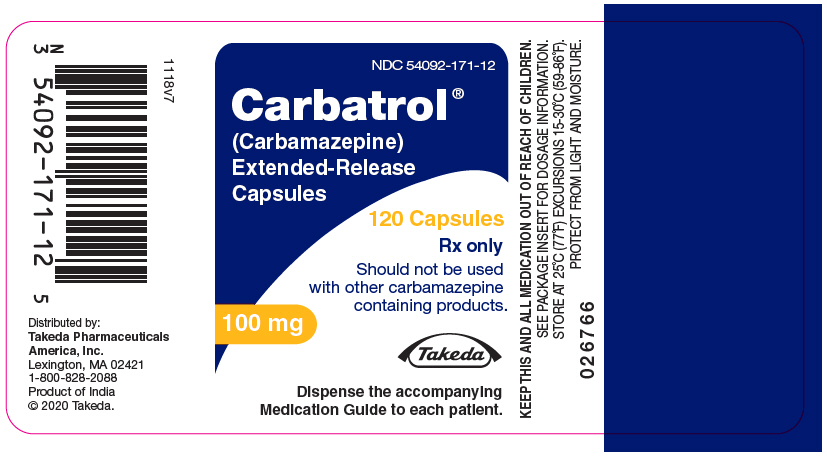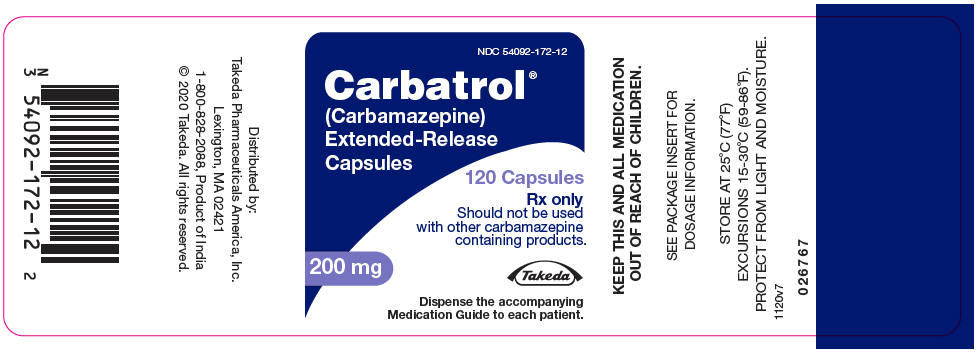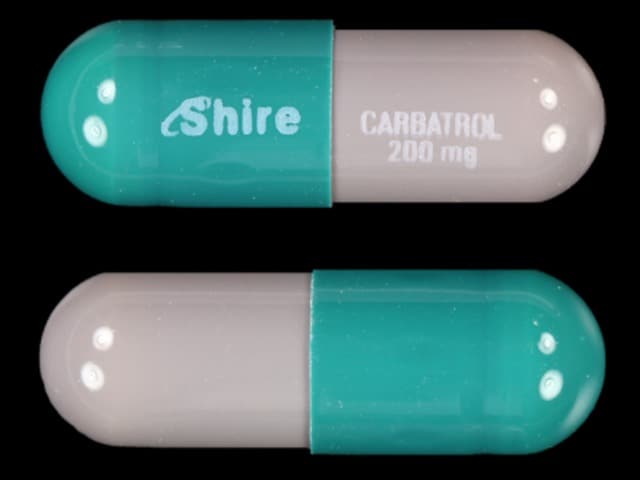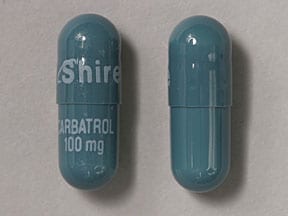Carbatrol
Generic name: carbamazepine (oral)
Brand names: Carbatrol, Epitol, Equetro, TEGretol, TEGretol XR
Drug class: Dibenzazepine anticonvulsants
Medically reviewed by A Ras MD.
What is Carbatrol?
Carbatrol is a medicine used to treat certain types of seizures (partial, tonic-clonic, mixed), certain types of nerve pain (trigeminal and glossopharyngeal neuralgia). Carbatrol is not a regular pain medicine and should not be used for aches or pains.
Description
CARBATROL® is an anticonvulsant and specific analgesic for trigeminal neuralgia, available for oral administration as 100 mg, 200 mg and 300 mg extended-release capsules of Carbamazepine, USP. Carbamazepine is a white to off-white powder, practically insoluble in water and soluble in alcohol and in acetone. Its molecular weight is 236.27. Its chemical name is 5H-dibenz[b,f]azepine-5-carboxamide, and its structural formula is:

Carbatrol® is a multi-component capsule formulation consisting of three different types of beads: immediate-release beads, extended-release beads, and enteric-release beads. The three bead types are combined in a specific ratio to provide twice daily dosing of Carbatrol®.
Inactive ingredients: citric acid, colloidal silicon dioxide, lactose monohydrate, microcrystalline cellulose, polyethylene glycol, povidone, sodium lauryl sulfate, talc, triethyl citrate and other ingredients.
The 100 mg capsule shells contain gelatin-NF, FD&C Blue #2, Yellow Iron Oxide, and titanium dioxide and are imprinted with white ink; the 200 mg capsule shells contain gelatin-NF, FD&C Red #3, FD&C Yellow #6, Yellow Iron Oxide, FD&C Blue #2, and titanium dioxide, and are imprinted with white ink; and the 300 mg capsule shells contain gelatin-NF, FD&C Blue #2, FD&C Yellow #6, Red Iron Oxide, Yellow Iron Oxide, and titanium dioxide, and are imprinted with white ink.
What is the most important information I should know about Carbatrol?
Do not stop taking Carbatrol without first talking to your healthcare provider.
Stopping Carbatrol suddenly can cause serious problems.
Carbatrol can cause serious side effects, including:
1. Carbatrol may cause rare but serious rashes that may lead to death. These serious skin reactions are more likely to happen within the first four months of Carbatrol treatment but may occur at later times. These reactions can happen in anyone, but are more likely in people of Asian descent. If you are of Asian descent you may need a genetic blood test before you take Carbatrol to see if you are at a higher risk for serious skin reactions with this medicine. Symptoms may include:
- skin rash
- hives
- sores in your mouth
- blistering or peeling of the skin
2. Carbatrol can also cause other types of allergic reactions or serious problems that may affect organs and other parts of your body such as your liver or blood cells. You may or may not have a rash when you get these types of reactions. Call your healthcare provider right away if you have any of these symptoms:
- frequent fevers or fevers that do not go away
- frequent infections or an infection that does not go away
- unusual bruising or bleeding
- red or purple spots on your body
- severe fatigue or weakness
- unexpected muscle pain that does not go away
- swelling of your face, eyes, lips, or tongue
- swollen glands that do not go away
- yellowing of your skin or the whites of your eyes
- loss of appetite (anorexia) that does not go away
- nausea or vomiting that does not go away
These symptoms may be the first signs of a serious reaction. A healthcare provider should examine you to decide if you should continue taking Carbatrol.
3. Like other antiepileptic drugs, Carbatrol may cause suicidal thoughts or actions in a very small number of people, about 1 in 500.
Call your healthcare provider right away if you have any of these symptoms, especially if they are new, worse, or worry you:
- thoughts about suicide or dying
- attempt to commit suicide
- new or worse depression
- new or worse anxiety
- feeling agitated or restless
- panic attacks
- trouble sleeping (insomnia)
- new or worse irritability
- acting aggressive, being angry, or violent
- acting on dangerous impulses
- an extreme increase in activity and talking (mania)
- other unusual changes in behavior or mood
How can I watch for early symptoms of suicidal thoughts and actions?
- Pay attention to any changes, especially sudden changes, in mood, behaviors, thoughts, or feelings.
- Keep all follow-up visits with your healthcare provider as scheduled.
- Call your healthcare provider between visits as needed, especially if you are worried about symptoms.
Do not stop Carbatrol without first talking to a healthcare provider.
Stopping Carbatrol suddenly can cause serious problems.
Suicidal thoughts or actions can be caused by things other than medicines. If you have suicidal thoughts or actions, your healthcare provider may check for other causes.
Who should not take Carbatrol?
Do not take Carbatrol if you:
- have a history of bone marrow depression
- are allergic to carbamazepine or any of the ingredients in Carbatrol. See the end of this Medication Guide for a complete list of ingredients in Carbatrol.
- take nefazodone
- take delavirdine
- are allergic to antidepressant medications called tricyclic (TCAs).
- have taken a medicine called Monoamine Oxidase Inhibitor (MAOI) in the last 14 days.
Ask your healthcare provider or pharmacist for a list of these medicines if you are not sure.
What should I tell my healthcare provider before taking Carbatrol?
Before you take Carbatrol, tell your healthcare provider if you:
- have or ever had heart problems
- have or ever had blood problems
- have or ever had liver or kidney problems
- have or ever had allergic reactions to medicines
- have or ever had increased pressure in your eye
- have or have had suicidal thoughts or actions, depression or mood problems
- have any other medical conditions
- drink grapefruit juice or eat grapefruit
- use birth control. Carbatrol may make your birth control less effective. Tell your healthcare provider if your menstrual bleeding changes while you take birth control and Carbatrol.
- are pregnant or plan to become pregnant. Carbatrol may harm your unborn baby. Tell your healthcare provider right away if you become pregnant while taking Carbatrol. You and your healthcare provider should decide if you should take Carbatrol while you are pregnant.
- If you become pregnant while taking Carbatrol, talk to your healthcare provider about registering with the North American Antiepileptic Drug (NAAED) Pregnancy Registry. The purpose of this registry is to collect information about the safety of antiepileptic medicine during pregnancy. You can enroll in this registry by calling 1-888-233-2334.
- are breastfeeding or plan to breastfeed. Carbatrol passes into breast milk. You and your healthcare provider should discuss whether you should take Carbatrol or breastfeed. You should not do both.
Tell your healthcare provider about all the medicines you take, including prescription and non-prescription medicines, vitamins, and herbal supplements.
Taking Carbatrol with certain other medicines can cause side effects or affect how well they work. Do not start or stop other medicines without talking to your healthcare provider.
Know the medicines you take. Keep a list of them and show it to your healthcare provider and pharmacist when you get a new medicine.
How should I take Carbatrol?
- Take Carbatrol exactly as prescribed. Your doctor will tell you how much Carbatrol to take.
- Your healthcare provider may change your dose. Do not change your dose of Carbatrol without talking to your healthcare provider.
- Do not stop taking Carbatrol without first talking to your healthcare provider. Stopping Carbatrol suddenly can cause serious problems. Stopping seizure medicine suddenly in a patient who has epilepsy can cause seizures that will not stop (status epilepticus).
- Take Carbatrol with or without food.
- Do not crush, chew, or break Carbatrol capsules or the beads inside of the capsules. But, Carbatrol capsules can be opened and sprinkled over food such as a teaspoon of applesauce. Tell your healthcare provider if you can not swallow Carbatrol whole.
- If you take too much Carbatrol, call your healthcare provider or local Poison Control Center right away.
What should I avoid while taking Carbatrol?
- Do not drink alcohol or take other drugs that may make you sleepy or dizzy while taking Carbatrol until you talk to your healthcare provider. Carbatrol taken with alcohol or drugs may make your sleepiness or dizziness worse.
- Do not drive, or operate heavy machinery, or do other dangerous activities until you know how Carbatrol affects you. Carbatrol can slow your thinking and motor skills.
What are the possible side effects of Carbatrol?
See “What is the most important information I should know about Carbatrol?”
Carbatrol may cause other serious side effects including:
- Irregular heartbeat – symptoms include:
- Fast, slow, or pounding heartbeat
- Shortness of breath
- Feeling lightheaded
- Fainting
- Liver problems – symptoms include:
- yellowing of your skin or the whites of your eyes
- dark urine
- pain on the right side of your stomach area (abdominal pain)
- easy bruising
- loss of appetite
- nausea or vomiting
Get medical help right away if you have any of the symptoms listed above or listed in “What is the most important information I should know about Carbatrol?”.
The most common side effects of Carbatrol include:
- dizziness
- drowsiness
- problems with walking and coordination (unsteadiness)
- nausea
- vomiting
These are not all the side effects of Carbatrol. For more information, ask your healthcare provider or pharmacist.
Tell your healthcare provider if you have any side effect that bothers you or that does not go away.
Call your doctor for medical advice about side effects. You may report side effects to FDA at 1-800-FDA-1088.
General information about the safe and effective use of Carbatrol
Medicines are sometimes prescribed for purposes other than those listed in a Medication Guide. Do not use Carbatrol for a condition for which it was not prescribed. Do not give Carbatrol to other people, even if they have the same symptoms that you have. It may harm them.
This Medication Guide summarizes the most important information about Carbatrol. If you would like more information, talk with your healthcare provider. You can ask your pharmacist or healthcare provider for information about Carbatrol that is written for health professionals.
For more information go to www.carbatrol.com or call 1-800-828-2088.
How should I store Carbatrol?
- Store Carbatrol between 59°F to 86°F (15°C to 30°C).
- Keep Carbatrol out of the light.
- Keep Carbatrol capsules dry.
Keep Carbatrol and all medicines out of the reach of children.
What are the ingredients in Carbatrol?
Active ingredient: carbamazepine
Inactive ingredients: citric acid, colloidal silicon dioxide, lactose monohydrate, microcrystalline cellulose, polyethylene glycol, povidone, sodium lauryl sulfate, talc, triethyl citrate and Eudragit.
In addition:
- the 100 mg capsules contain gelatin-NF, FD&C Blue #2, Yellow Iron Oxide, and titanium dioxide and are imprinted with white ink
- the 200 mg capsules contain gelatin-NF, FD&C Red #3, FD&C Yellow #6, Yellow Iron Oxide, FD&C Blue #2, and titanium dioxide, and are imprinted with white ink
- the 300 mg capsules contain gelatin-NF, FD&C Blue #2, FD&C Yellow #6, Red Iron Oxide, Yellow Iron Oxide, and titanium dioxide, and are imprinted with white ink
Label
PRINCIPAL DISPLAY PANEL – 100 MG CAPSULE BOTTLE LABEL
- NDC 54092-171-12
- Carbatrol®
(Carbamazepine)
Extended-Release
Capsules - 120 Capsules
- Rx only
- Should not be used
with other carbamazepine
containing products. - 100 mg
- Takeda
- Dispense the accompanying
Medication Guide to each patient.

PRINCIPAL DISPLAY PANEL – 200 MG CAPSULE BOTTLE LABEL
- NDC 54092-172-12
- Carbatrol®
(Carbamazepine)
Extended-Release
Capsules - 120 Capsules
- Rx only
- Should not be used
with other carbamazepine
containing products. - 200 mg
- Takeda
- Dispense the accompanying
Medication Guide to each patient.


SRC: NLM .

